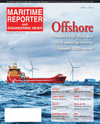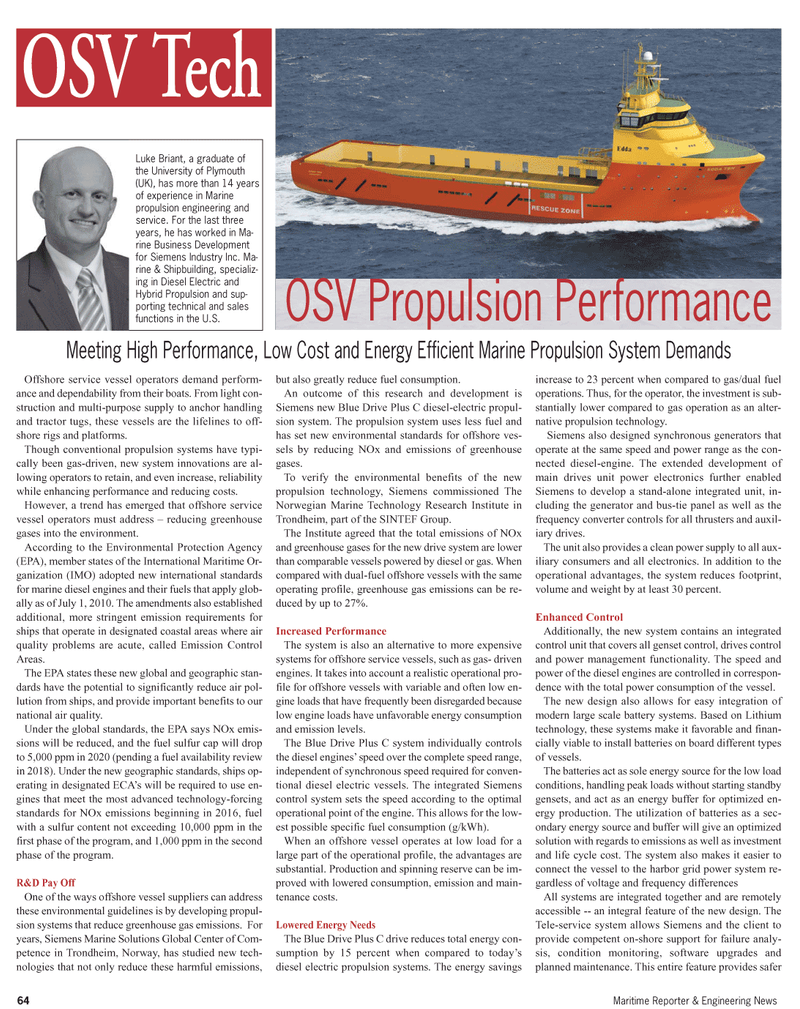
Page 68: of Maritime Reporter Magazine (April 2012)
Offshore Deepwater Annual
Read this page in Pdf, Flash or Html5 edition of April 2012 Maritime Reporter Magazine
64Maritime Reporter & Engineering News Offshore service vessel operators demand perform- ance and dependability from their boats. From light con-struction and multi-purpose supply to anchor handlingand tractor tugs, these vessels are the lifelines to off- shore rigs and platforms. Though conventional propulsion systems have typi- cally been gas-driven, new system innovations are al- lowing operators to retain, and even increase, reliability while enhancing performance and reducing costs.However, a trend has emerged that offshore service vessel operators must address ? reducing greenhouse gases into the environment. According to the Environmental Protection Agency (EPA), member states of the International Maritime Or- ganization (IMO) adopted new international standards for marine diesel engines and their fuels that apply glob-ally as of July 1, 2010. The amendments also established additional, more stringent emission requirements forships that operate in designated coastal areas where airquality problems are acute, called Emission ControlAreas. The EPA states these new global and geographic stan- dards have the potential to significantly reduce air pol- lution from ships, and provide important benefits to our national air quality. Under the global standards, the EPA says NOx emis- sions will be reduced, and the fuel sulfur cap will dropto 5,000 ppm in 2020 (pending a fuel availability review in 2018). Under the new geographic standards, ships op- erating in designated ECAs will be required to use en- gines that meet the most advanced technology-forcing standards for NOx emissions beginning in 2016, fuel with a sulfur content not exceeding 10,000 ppm in the first phase of the program, and 1,000 ppm in the second phase of the program.R&D Pay Off One of the ways offshore vessel suppliers can address these environmental guidelines is by developing propul- sion systems that reduce greenhouse gas emissions. For years, Siemens Marine Solutions Global Center of Com-petence in Trondheim, Norway, has studied new tech- nologies that not only reduce these harmful emissions,but also greatly reduce fuel consumption. An outcome of this research and development is Siemens new Blue Drive Plus C diesel-electric propul- sion system. The propulsion system uses less fuel and has set new environmental standards for offshore ves- sels by reducing NOx and emissions of greenhousegases. To verify the environmental benefits of the new propulsion technology, Siemens commissioned The Norwegian Marine Technology Research Institute in Trondheim, part of the SINTEF Group. The Institute agreed that the total emissions of NOxand greenhouse gases for the new drive system are lower than comparable vessels powered by diesel or gas. When compared with dual-fuel offshore vessels with the same operating profile, greenhouse gas emissions can be re- duced by up to 27%.Increased Performance The system is also an alternative to more expensive systems for offshore service vessels, such as gas- driven engines. It takes into account a realistic operational pro- file for offshore vessels with variable and often low en- gine loads that have frequently been disregarded because low engine loads have unfavorable energy consumption and emission levels. The Blue Drive Plus C system individually controls the diesel engines speed over the complete speed range, independent of synchronous speed required for conven- tional diesel electric vessels. The integrated Siemens control system sets the speed according to the optimaloperational point of the engine. This allows for the low- est possible specific fuel consumption (g/kWh). When an offshore vessel operates at low load for a large part of the operational profile, the advantages are substantial. Production and spinning reserve can be im- proved with lowered consumption, emission and main- tenance costs. Lowered Energy Needs The Blue Drive Plus C drive reduces total energy con- sumption by 15 percent when compared to todays diesel electric propulsion systems. The energy savings increase to 23 percent when compared to gas/dual fuel operations. Thus, for the operator, the investment is sub- stantially lower compared to gas operation as an alter- native propulsion technology. Siemens also designed synchronous generators thatoperate at the same speed and power range as the con- nected diesel-engine. The extended development of main drives unit power electronics further enabled Siemens to develop a stand-alone integrated unit, in- cluding the generator and bus-tie panel as well as the frequency converter controls for all thrusters and auxil- iary drives. The unit also provides a clean power supply to all aux- iliary consumers and all electronics. In addition to theoperational advantages, the system reduces footprint, volume and weight by at least 30 percent. Enhanced Control Additionally, the new system contains an integrated control unit that covers all genset control, drives control and power management functionality. The speed and power of the diesel engines are controlled in correspon- dence with the total power consumption of the vessel. The new design also allows for easy integration of modern large scale battery systems. Based on Lithium technology, these systems make it favorable and finan- cially viable to install batteries on board different types of vessels. The batteries act as sole energy source for the low load conditions, handling peak loads without starting standbygensets, and act as an energy buffer for optimized en- ergy production. The utilization of batteries as a sec- ondary energy source and buffer will give an optimized solution with regards to emissions as well as investment and life cycle cost. The system also makes it easier to connect the vessel to the harbor grid power system re- gardless of voltage and frequency differences All systems are integrated together and are remotely accessible -- an integral feature of the new design. The Tele-service system allows Siemens and the client to provide competent on-shore support for failure analy- sis, condition monitoring, software upgrades and planned maintenance. This entire feature provides safer OSV Tech OSV Propulsion Performance Luke Briant, a graduate ofthe University of Plymouth(UK), has more than 14 years of experience in Marinepropulsion engineering and service. For the last three years, he has worked in Ma-rine Business Developmentfor Siemens Industry Inc. Ma-rine & Shipbuilding, specializ-ing in Diesel Electric andHybrid Propulsion and sup- porting technical and sales functions in the U.S.Meeting High Performance, Low Cost and Energy Efficient Marine Propulsion System Demands

 67
67

 69
69
